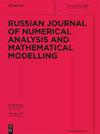Herd immunity levels and multi-strain influenza epidemics in Russia: a modelling study
IF 0.6
4区 数学
Q4 MATHEMATICS, APPLIED
Russian Journal of Numerical Analysis and Mathematical Modelling
Pub Date : 2021-11-01
DOI:10.1515/rnam-2021-0023
引用次数: 2
Abstract
Abstract In the present paper, we consider a compartmental epidemic model which simulates the co-circulation of three influenza strains, A(H1N1)pdm09, A(H3N2), and B, in a population with the history of exposure to these virus strains. A strain-specific incidence data for the model input was generated using long-term weekly ARI incidence and virologic testing data. The algorithm for model calibration was developed as a combination of simulated annealing and BFGS optimization methods. Two simulations were carried out, assuming the absence and the presence of protected individuals in the population, with 2017– 2018 and 2018–2019 epidemic seasons in Moscow as a case study. It was shown that strain-specific immune levels defined by virologic studies might be used in the model to obtain plausible incidence curves. However, different output parameter values, such as fractions of individuals exposed to particular virus strain in the previous epidemic season, can correspond to similar incidence trajectories, which complicates the assessment of herd immunity levels based on the model calibration. The results of the study will be used in the research of the interplay between the immunity formation dynamics and the circulation of influenza strains in Russian cities.俄罗斯群体免疫水平和多株流感流行:一项模型研究
摘要在本文中,我们考虑了一个分区流行病模型,该模型模拟了三种流感毒株,a(H1N1)pdm09、a(H3N2)和B,在有接触这些病毒株历史的人群中的共同循环。使用长期每周ARI发病率和病毒学检测数据生成模型输入的菌株特异性发病率数据。模型校准算法是将模拟退火和BFGS优化方法相结合而开发的。假设人群中不存在和存在受保护的个体,进行了两次模拟,以莫斯科的2017-2018年和2018-2019年疫情季节为例进行了研究。研究表明,病毒学研究定义的菌株特异性免疫水平可用于该模型,以获得合理的发病率曲线。然而,不同的输出参数值,例如在上一个流行季节暴露于特定病毒株的个体的分数,可能对应于相似的发病轨迹,这使基于模型校准的群体免疫水平评估变得复杂。这项研究的结果将用于研究免疫形成动力学与俄罗斯城市流感毒株传播之间的相互作用。
本文章由计算机程序翻译,如有差异,请以英文原文为准。
求助全文
约1分钟内获得全文
求助全文
来源期刊
CiteScore
1.40
自引率
16.70%
发文量
31
审稿时长
>12 weeks
期刊介绍:
The Russian Journal of Numerical Analysis and Mathematical Modelling, published bimonthly, provides English translations of selected new original Russian papers on the theoretical aspects of numerical analysis and the application of mathematical methods to simulation and modelling. The editorial board, consisting of the most prominent Russian scientists in numerical analysis and mathematical modelling, selects papers on the basis of their high scientific standard, innovative approach and topical interest.
Topics:
-numerical analysis-
numerical linear algebra-
finite element methods for PDEs-
iterative methods-
Monte-Carlo methods-
mathematical modelling and numerical simulation in geophysical hydrodynamics, immunology and medicine, fluid mechanics and electrodynamics, geosciences.

 求助内容:
求助内容: 应助结果提醒方式:
应助结果提醒方式:


